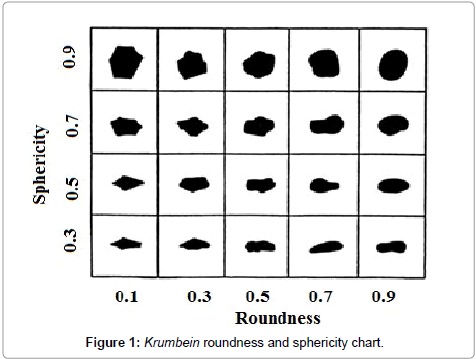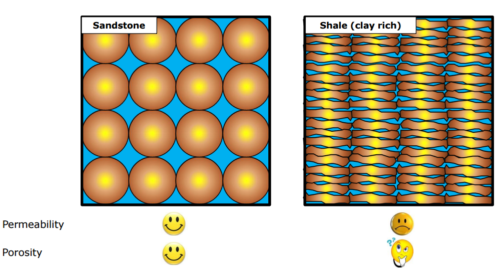Tag Archive: Frac
Roundness, Sphericity and Microproppants
Gravel, sand, and other aggregates must be separated and classified based on their sphericity and roundness to determine the suitability for various applications. These two terms describe the shape of these materials in two different dimensions.
- Sphericity measures how close the rock is to a perfect sphere.
- Roundness is a measurement of the edge of the rock.
These measurements provide a means of documenting the difference between various shapes, such as rhombus and a football, or a circle and an octagon. The mathematical equations for determining roundness and sphericity can be found here.
The Krumbein Roundness and Sphericity Chart
Most applications for aggregate don’t require the level of accuracy provided by the above mathematical calculations, so a simple visual test is easier and faster. The Krumbein Roundness and Sphericity Chart has been widely adopted as a visual method for determining the shape of an aggregate. This chart can be seen in Figure 1.

Applications in the Oil and Gas Industry
Measuring sphericity and roundness is critical for fracking operations in the oil and gas sector, as these properties determine the strength and permeability of the aggregate. Silica sand’s ability to withstand high compression stresses depends on both of these factors. If the sand is on the low end of the sphericity and roundness chart, the particles will have too many sharp edges.
When compressive forces are applied directly to those edges, the stress concentrations increase exponentially. If the sand is under too much stress, it will shatter, further increasing the amount of jagged-edged particles. This process can have a domino effect until nothing remains but a vein of silica dust deep in the ground.
Silica sand serves two purposes in fracking:
- It acts as a proppant, which props open the cracks in the shale.
- It allows oil to flow back to the well head.
Fracking sand must remain permeable or it has the opposite of its intended effect. Without gaps between the grains of sand, oil cannot flow between the particles. If the silica turns to dust, it instead blocks the flow of oil.
Microproppants
Sand particles smaller than U.S. Sieve size 140 mesh are referred to as microproppants. There are smaller silica products known as silica flour, but these flours are ground into dust and rate very low on the sphericity and roundness chart. Silica flour is too jagged and has very low crush strength.
As a visual reference, imagine stacking basketballs. The rounded edges of the balls provide space for fluid to flow between each ball. Silica flour is more like stacking Legos. There is no space to allow oil to flow back into the well head between each “Lego.” See Figure 2.

For fracking, it’s important to source silica sand that is still whole-grain rather than ground or crushed, ensuring that oil will still be able to flow between the grains. Figure 3 below is a photo of 200-grain mesh whole-grain silica sand. The dark column is a 0.7 mm pencil lead as a size reference.

These whole-grain microproppants rank much higher on the sphericity and roundness chart, and thus feature a higher crush resistance than ground silica flours. This ultimately adds to the productivity and service life of the well.
Silica Products From MS Industries
MS Industries provides high-quality whole-grain silica products for use in oil and gas applications. Our silica sand features consistent size, color, chemistry, ensuring reliable well performance with an optimal service life. For more information about our silica sand products, please contact us or request a quote.
API Frac Sand Standards and Microproppants
Recently, smaller grains of sand are in demand in the oil and gas markets. While fracking processes started with coarser grains of sand, the market is trending toward finer mesh size silica grains.
At first, fracking used silica sand with mesh such as 16-30, 20-40, and 30-50. In the years since, however, the markets have made 40-70 and 70-140 mesh sizes the default standard. In this article, we’ll discuss the role of frac sand and other proppants in the oil and gas markets, as well as what the industry can expect in the race to mine finer silica sand.
What Is Frac Sand?
Frac sand is a particular type of sand that’s used in hydraulic fracking. Shale and other low-permeability reservoirs may have relatively low amounts of fossil fuels, but they have enough to be increasingly viable in competitive oil and gas markets. Both oil and natural gas markets use frac sand to prop open wells to produce natural gas, oil, and other energy-rich fluids from fracking sites.
Frac sand, which is crystalline sand derived from high-purity sandstone, has unique properties that oil and gas producers need. The quartz grains are naturally occurring, crush-resistant, and come in an extensive range of grain sizes for different operations. Frac is purely silica quartz, whereas other sands—like most intercoastal sands—are a mix of multiple different rocks and minerals.
Ultimately, silica sand offers highly consistent resistance to crushing and physical force to a degree that other sands can’t provide.
Proppants in the Oil and Gas Markets
Fracking processes break open shale reservoirs to extract natural gas, oil, and natural gas liquids. Once a site has been discovered, companies shoot highly pressurized jets of water into the reservoirs to create cracks and extract fossil fuels from the pores of the reservoir.
Because these cracks are under tremendous pressure from the surrounding rocks and earth, they will reseal as soon as water pressure diminishes. That’s where silica sand and other proppants come in: the material fills the widening crack to hold it open, even when the water jet moves on. This allows oil and gas companies to continue collecting material from the well for as long as possible. Because silica sand is resistant to crushing, the reservoir can’t easily reseal, and companies can more efficiently collect fuel for processing.
The Impact of Mesh Sizes
Frack technology is continuing to grow and evolve, and so is market access to increasingly specific varieties of silica sand. Companies are gradually shifting to prefer finer grains of frac sand.
Sand is measured through standardized sieve meshes that allow grains of different sizes through for sorting and categorizing. At first, larger mesh sizes, and correspondingly coarse sand grain sizes, were sufficient to mete out sand that allowed companies to extract fossil fuels from shale reservoirs.
Today, many companies use advanced fracking practices and smaller grain sizes to increase the proppants’ grip in the reservoirs and collect more fuel. Finer sands allow companies to both increase daily barrel production and pull from the same well longer.
407-0 and 70-140 grain size silica sand can push deeper into fine cracks and gaps in shale. Once the sand locks into place, it can hold the crack open and continue to wedge deeper into the shale.
How can finer sand go deeper into the well?
Because fracking uses pressurized water to form the cracks in the first place, the addition of sand quickly forms a slurry. This slurry is slow, thick, and unable to reach into every crevice of the new cracks. Finer sand, however, is more resistant to forming a thick, slow slurry. It has a better Settling Velocity Rate (SVR) and goes deeper into cracks before the velocity decreases.
Not only can companies reach deeper into a reservoir, but the finer sands increase overall surface area coverage of the shale cracks. The bigger the area of exposed pores, the more natural gas, liquid, and oil the company can extract per day and per well.
Frac Sand Mining
Fracking processes rely on finely controlled water and sand to extract as much fuel as possible from shale and low-permeability reservoirs. The water creates cracks and empty spaces in the rock formations, and the sand props the gaps open for longer extraction windows.
This sand demand isn’t negligible; each well requires up to 10,000 tons of sand. With the developing need for finer sand, the demand is also concentrating on just a few locations that can supply high-purity silica sand grains.
One of the most reliable locations for high-purity silicon dioxide sand in the United States is the region at the border of Minnesota and Wisconsin near the Great Lakes. This region produces highly spherical silica sand that’s close to the surface and consistently high quality.
Frac Sand From MS Industries II, LLC
We specialize in providing both high-quality materials and logistics management. Our team delivers silica sand at your company’s requested specifications and on time, every time. Contact our team today to learn about our frac sand solutions or request a quote to get your order started.
MS Industries Provides a New Source for Microproppants
Russellville, Alabama
MS Industries (“MSI”), is a mining and mineral development company and direct mining source located in Russellville Alabama, is a primary producer of a wide array of industrial silica products along with frac sand and silica flour for the oil and gas industries. MSI is now offering (>99% SiO2) “Super 100” whole-grain microproppants to the oil and gas industries. By utilizing Super 100, oil well production and lifespan increases with some recent testing and reports suggesting microproppant addition can increase oil well production up to a 15% -30% over a 12-month period.
“In recent years, microproppant use has been shown to increase production and provide additional benefits in oil well operations”, says John Christmas, COO of MSI. “One of the biggest obstacles was where purchasers could find a consistent and quality supplier of whole-grain microproppants, that is, until now”.
 It has been known that proppant selection has changed over the years, as the industry has continued to investigate and utilize smaller frac sands to increase well production. As the oil and gas industry grows and evolves, more companies are looking into methods for increasing production and life of the wells. The introduction of whole-grain microproppants into the fracturing fluids allows the secondary fractures to be stimulated thus allowing the secondary fractures to remain open upon pressure drawdown. This allows for the user to access all the wells potential and maximize the reservoir capacities.
It has been known that proppant selection has changed over the years, as the industry has continued to investigate and utilize smaller frac sands to increase well production. As the oil and gas industry grows and evolves, more companies are looking into methods for increasing production and life of the wells. The introduction of whole-grain microproppants into the fracturing fluids allows the secondary fractures to be stimulated thus allowing the secondary fractures to remain open upon pressure drawdown. This allows for the user to access all the wells potential and maximize the reservoir capacities.MSI’s Super 100, carries up to 25% whole-grain microproppant with particles ranging in the -150 mesh to 325 mesh size. Super 100 is available direct from MS Industries as are all its industrial silica products and silica flour.
For more information please contact Brian Pace, MS Industries, 256-383-6740.

